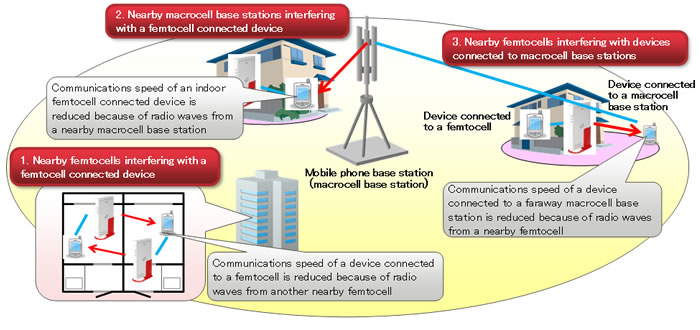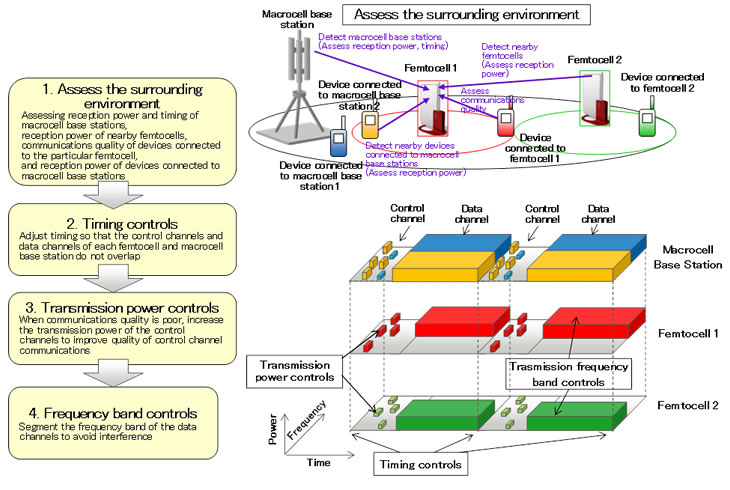Fujitsu Develops Technology that Automatically Reduces Radio Wave Interference for LTE Home Femtocells – Sep 10, 2013– Sunnyvale, USA (Techreleased) – Fujitsu Laboratories Ltd. and Fujitsu Laboratories of America, Inc. today announced development of technology that automatically reduces radio wave interference by detecting the environment around a femtocell to enable high-speed, high-quality indoor wireless communications.

Until now, when one femtocell was near either another femtocell or an outdoor macrocell base station, radio wave interference would distort communication signals. Fujitsu has now developed technology that enables the femtocell to detect its surroundings and automatically adjust the timing, transmission power, and transmission frequency band to reduce radio wave interference. In simulations, it was confirmed that this technology approximately doubles communication speeds in cases where there is significant radio wave interference, as compared to previous technology.
In home wireless environments, this technology will enable high-resolution video streams and allow applications such as online games to run smoothly.
Details of this technology will be presented at the 24th Annual IEEE International Symposium on Personal, Indoor and Mobile Radio Communications (PIMRC2013), opening in London on September 8, 2013.
Background
Femtocells are small cellular base stations that enable communications to run as fast as conventional outdoor macrocell base stations in terms of their maximum communication speed. With an indoor femtocell, devices need not communicate with outdoor macrocell base stations, resulting in better quality communications. In addition, because the wireless frequency band can be restricted to just a few users, there can be dramatic improvements in communication speeds of up to ten times or more. Femtocells, therefore, represent a solution to dead zones, where radio waves cannot reach mobile phones, as well as to communications traffic caused by an overall increase in wireless communication usage. Fujitsu has already commercialized its own femtocell, the BroadOne LTE Femtocell(1).
Technological Issues
Macrocell base stations are spaced in accordance with meticulous cell designs in order to prevent radio wave interference from other macrocell base stations. Femtocells, by contrast, are placed in users’ homes, and with large numbers of them it can be difficult to reduce radio wave interference. As a result, when one femtocell is near either another femtocell or an outdoor macrocell base station, radio wave interference distorts communications signals. Specifically, there are the following three types of potential interference.
1. Nearby femtocells interfering with a femtocell connected device
In this case, the communications speed of a device connected to a femtocell is reduced because of radio waves from another nearby femtocell.
2. Nearby macrocell base stations interfering with a femtocell connected device
In this case, the communications speed of an indoor femtocell connected device is reduced because of radio waves from a nearby macrocell base station.
3. Nearby femtocells interfering with devices connected to macrocell base stations
In this case, the communications speed of a device connected to a faraway macrocell base station is reduced because of radio waves from a nearby femtocell.

Figure 2. Sources of Femtocell Interference
The Newly Developed Technology
Fujitsu developed technology that enables the femtocell to detect its surroundings and automatically adjust the timing, transmission power, and transmission frequency band of its communications to reduce all three types of radio wave interference. Specifically, it manages interference through the sequence described below.
1. Assess the surrounding environment
The femtocell collects information on devices connected to it, surrounding macrocell base stations, macro base station connected devices, and other nearby femtocells.
2. Timing control
Based on the information on surrounding macrocell base stations, the timing of the femtocell’s signal transmissions are set in accordance with the timing of the signal transmissions of the surrounding macrocell base stations. As a result, interference in control channels and data channels are separated so as to diminish control channel interference.
3. Transmission power controls
Based on the information about the devices that are connected to it, when communications quality is compromised the femtocell can increase the transmission power of the control channels in order to maintain control channel quality. This stabilizes the device connections.
4. Frequency band controls
Based on information from nearby femtocells and macro devices connected to nearby macrocell base stations, the frequency band of the data channels is segmented to avoid interference from other femtocells or macrocell base stations. This raises data channel quality and increases communications speeds.

Figure 3. Diagram of the newly developed technology
In simulations, it was confirmed that, compared to before, this technology approximately doubles communication transmission speeds in cases where there is significant radio wave interference. It was also confirmed that communications became possible with macro devices that previously could not work properly due to severe interference.










